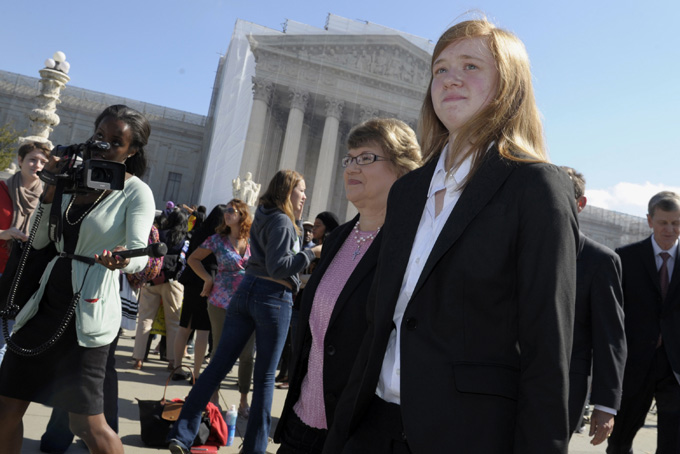
In this Oct. 10, 2012 file photo, Abigail Fisher, right, who sued the University of Texas, walks outside the Supreme Court in Washington. (AP Photo/Susan Walsh, File)
by Mark Sherman
WASHINGTON (AP) — Affirmative action in college admissions survived Supreme Court review Monday in a consensus decision that avoided the difficult constitutional issues surrounding a challenge to the University of Texas admission plan.
Justice Anthony Kennedy wrote the court’s 7-1 ruling that said a court should approve the use of race as a factor in admissions only after it concludes “that no workable race-neutral alternatives would produce the educational benefits of diversity.”
But the decision did not question the underpinnings of affirmative action, which the high court last reaffirmed in 2003.
The justices said the federal appeals court in New Orleans did not apply the highest level of judicial scrutiny when it upheld the Texas plan, which uses race as one among many factors in admitting about a quarter of the university’s incoming freshmen. The school gives the bulk of the slots to Texans who are admitted based on their high school class rank, without regard to race.
The high court ordered the appeals court to take another look at the case of Abigail Fisher, a white Texan who was not offered a spot at the university’s flagship Austin campus in 2008. Fisher has since received her undergraduate degree from Louisiana State University.
Justice Ruth Bader Ginsburg was the lone dissenter. “In my view, the courts below adhered to this court’s pathmarking decisions and there is no need for a second look,” Ginsburg said in a dissent she read aloud.
Justice Clarence Thomas, alone on the court, said he would have overturned the high court’s 2003 ruling, though he went along with Monday’s outcome.
Justice Elena Kagan stayed out of the case, presumably because she had some contact with it at an earlier stage when she worked in the Justice Department.
Kennedy said that courts must determine that the use of race is necessary to achieve the educational benefits of diversity, the Supreme Court’s standard for affirmative action in education since 1978. The high court most recently reaffirmed the constitutionality of affirmative action in Grutter v. Bollinger in 2003, a case involving the University of Michigan.
“As the Court said in Grutter, it remains at all times the university’s obligation to demonstrate, and the judiciary’s obligation to determine, that admissions processes ‘ensure that each applicant is evaluated as an individual and not in a way that makes an applicant’s race or ethnicity the defining feature of his or her application,'” Kennedy said.
University of Texas president Bill Powers said the university plans no immediate changes in its admissions policies as a result of Monday’s ruling and will continue to defend them in the courts.
“We remain committed to assembling a student body at the University of Texas at Austin that provides the educational benefits of diversity on campus while respecting the rights of all students and acting within the constitutional framework established by the court,” Powers said.
But Edward Blum, who helped engineer Fisher’s challenge, said it is unlikely that the Texas plan and many other college plans can long survive. “The Supreme Court has established exceptionally high hurdles for the University of Texas and other universities and colleges to overcome if they intend to continue using race preferences in their admissions policies, said Blum, director of The Project on Fair Representation in Alexandria, Va.
Civil rights activist Al Sharpton said the court “ducked” the big issues in the case. While he would have preferred that the justices affirm the use of race in college admissions, “a duck is better than a no, but not as good as a yes,” Sharpton said. Sharpton, along with Martin Luther King III, was leading a National Press Club news conference announcing initial plans to commemorate the 50th anniversary of the march on Washington.